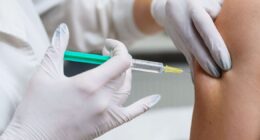
As for when to actually test yourself, it depends, although experts say you’re more likely to get accurate results when you have symptoms. “Take an at-home test when symptoms are present, or four to five days following a presumed exposure to someone who is ill and ideally another test 24 to 48 hours after that,” Joseph Petrosino, Ph.D., chair of the department of molecular virology and microbiology at Baylor College of Medicine, tells SELF.
At-home rapid tests can also come in handy before you gather with people, especially if a high-risk person will be there, like your elderly grandmother or a family member with an underlying illness, William Schaffner, M.D., an infectious disease specialist and professor at the Vanderbilt University School of Medicine, tells SELF. Rapid antigen tests can only tell if you’re infectious in that moment, which is why Dr. Schaffner says that you should “try to test as close to the event as possible.”
False results—especially false negatives—can and do happen, which is why experts say it’s so important to retest after 24 hours or so if you get a negative result but are still having symptoms. You can also make an appointment to get a polymerase chain reaction (PCR) test, which is considered the gold standard of COVID-19 testing, Dr. Petrosino says. “There are several other viruses—e.g., flu—present in the community right now that could be responsible, but it’s best to test to be sure,” he says.
READ RELATED: 6 Things Happen to Your Body If You Drink Ginger Tea Everyday
How can I get at-home COVID-19 tests for free?
On Tuesday, January 18, the White House launched a website where everyone can request up to four COVID-19 tests per household for free. There has been plenty of public criticism about a lack of a proper federal response to COVID-19 in both the Trump and Biden administrations. That criticism has extended to a lack of readily available rapid tests, and while the free-test program is a positive step in increasing access to testing, it’s not without flaws. In addition to the limited number of tests available for each household—a particular challenge for the more than 50 million people in the U.S. who live in multigenerational households—some users reported glitches with the website during the beta period, CNN reported, with users being told their household had already requested tests.
Given those significant challenges, you can still try to request tests. Go to COVIDtests.gov, fill in your name and mailing address, then wait 7 to 12 days for the tests to ship. (At this time,you do not have the option to select the brand of test you’d like to receive.) For more details on this announcement, go here.
In related news, the government also announced that private insurance companies would now be required to reimburse subscribers for up to eight at-home COVID tests per person, per month. In other words, whether your insurance is provided through your place of employment or if it was purchased on the open market, most insurance plans should now cover the cost of the tests up-front at the time of purchase or will ask you to save a receipt and submit a claim, according to the Centers for Medicare and Medicaid Services.
Source: SELF









